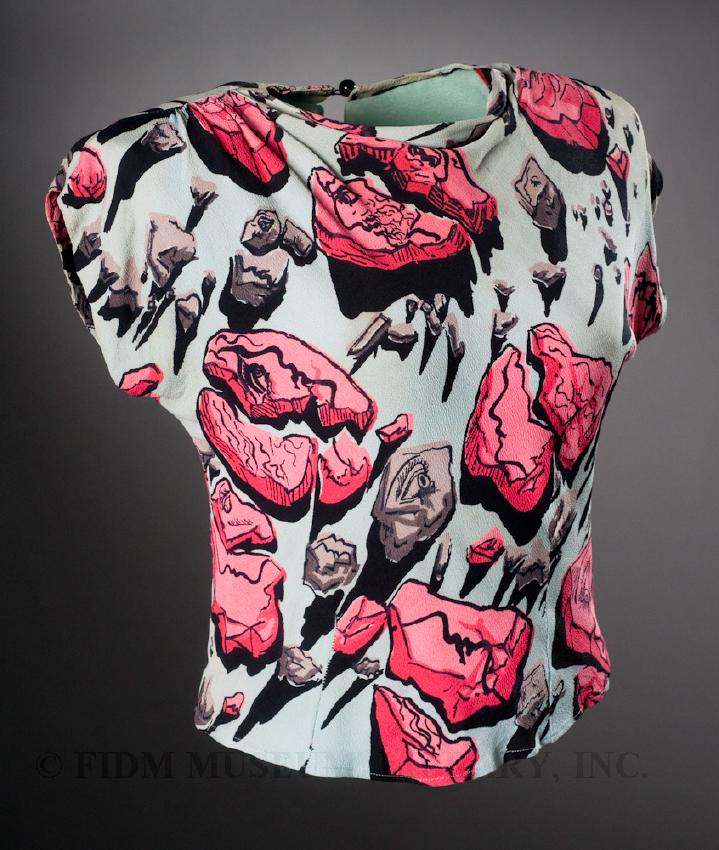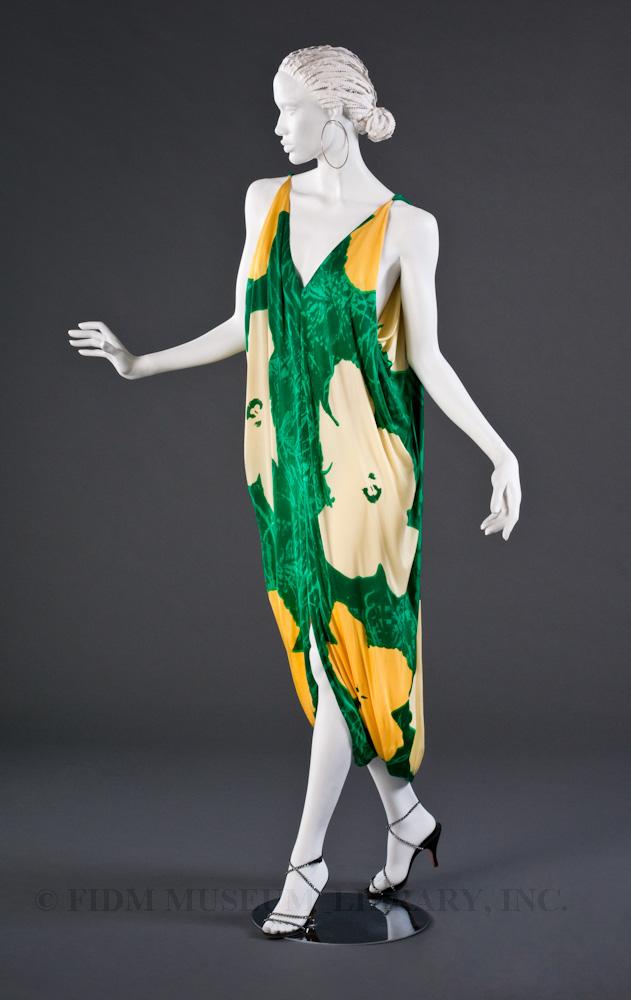Today's post was written by our Assistant Registrar Dani Killam. In her post, Dani explores the interplay between fashion designers and artists in two vibrantly colorful pieces from our collection: an Adrian blouse and a Halston dress. The Halston dress featured in this post is currently on exhibit in FABULOUS! and both are featured in the exhibition catalogue.
*******************
Though created 27 years apart, our Gilbert Adrian (1903-1959) blouse and Roy Halston (1932-1990) dress share a common theme prevalent within fashion design during the twentieth century. Adrian’s blouse showcases Salvador Dalí’s (1904-1989) shattered rock motif, while Halston’s garment is covered with Andy Warhol’s 1964 Flowers print. These two pieces from the FIDM Museum collection exemplify the symbiotic relationship and transformation of inspirational role from fashion to art, and art to fashion.
In preceding centuries artists were intrigued by the fashions they observed, absorbing details and angles of sartorial wonder that we in the museum field greatly benefit from today. The significance of such relations between artist and fashion may best be represented by French painter Jean-Antoine Watteau (1684-1721). The box pleats located at the center back of a dress à la française later became known as “Watteau pleats” due to the artist’s multiple representations of this fashionable construction. In Watteau's painting The Two Cousins, the the artist's namesake pleat is clearly portrayed. Jean-Auguste-Dominique Ingres, Franz-Xaver Winterhalter, James Tissot, John Singer Sargent, Claude Monet, and Edouard Manet are only a few of many artists who also produced artwork portraying dress as their main focal point. Clearly, fashion has a long history of inspiring art.
 Blouse
Blouse
Spring/Summer 1947
Gilbert Adrian, Designer
Salvador Dalí, Textile Artist
Enka rayon
Museum Purchase
2008.25.10
Then the tables began to turn. In the twentieth century, fashion houses began to find inspiration for their designs from individual artists and art movements. Salvador Dalí of the Surrealist movement worked with multiple design houses and produced textiles such as the shattered rock motif used by Adrian. This pattern dates from Dali's 1947 collaboration with Simpson, for whom he produced seven designs. Though the design of the garment is true to its era of the 1940s with its broad shoulders, the use of Dali’s imagery offers a deeper understanding of the times. Surrealism began in the 1920s as an art movement that gave psychological and philosophical insight by portraying images in a non sequitur fashion. Though the movement reached its golden era in the late 1930s, we can clearly see the lasting influence of Surrealism in this juxtaposition between one of America’s top designers and the great Surrealist leader.
 Evening Dress
Evening Dress
Fall 1974
Halston, Designer
Andy Warhol, Textile Artist
Printed silk jersey
Gift of Steven Porterfield
2010.897.3
Our Halston piece is next in line to embody the relationship of art and fashion. This dress showcases both artists with full clarity. Halston’s minimalist approach is evident in his use of jersey and beautiful draping that accentuates the female form. Halston didn't use prints very often during his career, but when applied they made an impact that did not over-shadow his design talent. In his Fall 1974 collection, Halston featured abstract prints by Jackson Pollock, Frank Stella and Andy Warhol. The dynamic green and yellow print seen above is based on Andy Warhol’s striking and clean 1964 screen print Flowers. Warhol's image was based on a photograph taken by Patricia Caulfield featured in Modern Photography magazine the same year he produced his silkscreen prints. This method of reinterpreting objects and images to give new meaning is true to Warhol’s Pop Art roots.
Whatever the inspiration, fashion or art, art of fashion, it is clear that these two worlds beautifully coexist. As a fashion historian, I cannot help but be grateful for this dimensional storytelling.

